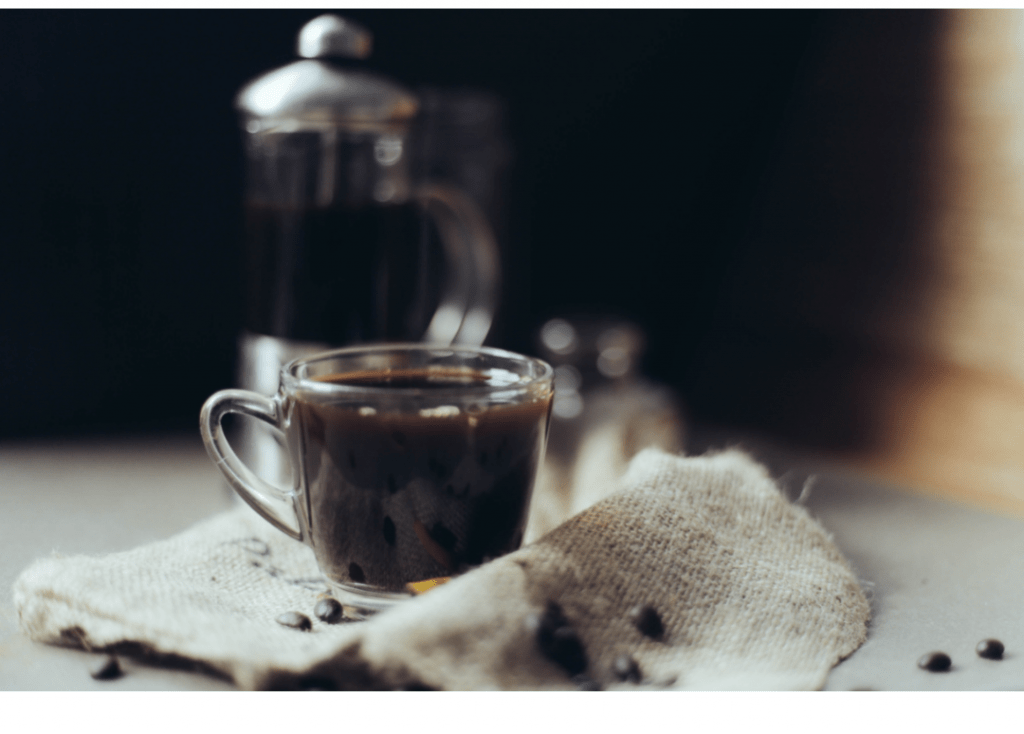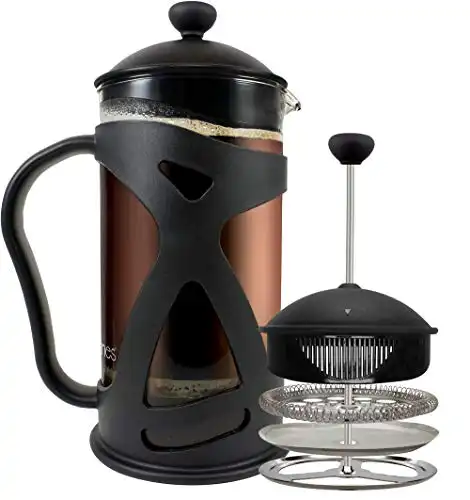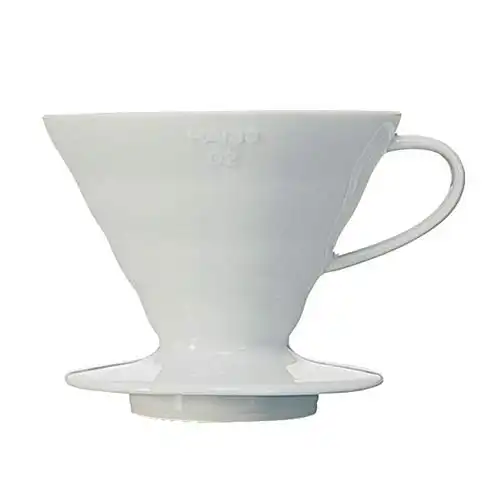- French Press Overview
- How Does the French Press Coffee Maker Work?
- How to Use a French Press to Brew Tasty Coffee
- Tips for French Press Brewing Perfection
- Advantages of the French Press
- Disadvantages of French press
- Pour Over Overview
- Who uses pour over the most?
- How It Works
- Tips for a Perfect Pour Over Brew
- Advantages of Pour Over
- Disadvantages of Pour Over
- Our Top Pick for French Press: Kona French Press
- Our Top Pick for Pour Over: Hario V60 Ceramic Pour Over
- Final Word
The coffee beans you ordered have just arrived.
Now you are wondering which brewing method will make your drink the most delicious.
French press vs. pour over? That is the question.
These manual brewing methods are not only popular among coffee snobs and well-heeled gourmets. Home coffee brewers love them too and for a good reason: convenience.
Wondering which method to use?
You’re in good company.
In this guide, we take a detailed look at French press vs. pour over.
Specifically, we’ll focus on how each method works, the pros, and cons of each method, and our top picks for each.
Let’s jump in.
We want you to know this post contains affiliate links. If you click on a product and decide to buy it we may earn a small commission at no extra cost to you.
French Press Overview
Interestingly, French press was invented back in the 1920s, but it’s one of the most preferred coffee brewing methods in the 21st century in Europe and the United States.
Are you new to the world of manual coffee brewing and are probably wondering how French press works?
It’s not as difficult as you might think.
Let’s start by looking at how it all works.
How Does the French Press Coffee Maker Work?
A French press brewer typically works by immersing coffee grounds into hot water.
The coffee maker separates grounds from the liquid coffee when you press down the filter.
For an optimal flavor extraction, water should be approximately 200℉. If you go above this point, you risk over-extraction, which is likely to make your coffee bitter.
On the other hand, if you brew the coffee at a lower temperature, it will be under-extracted, leading to a flavorless and watered down taste.
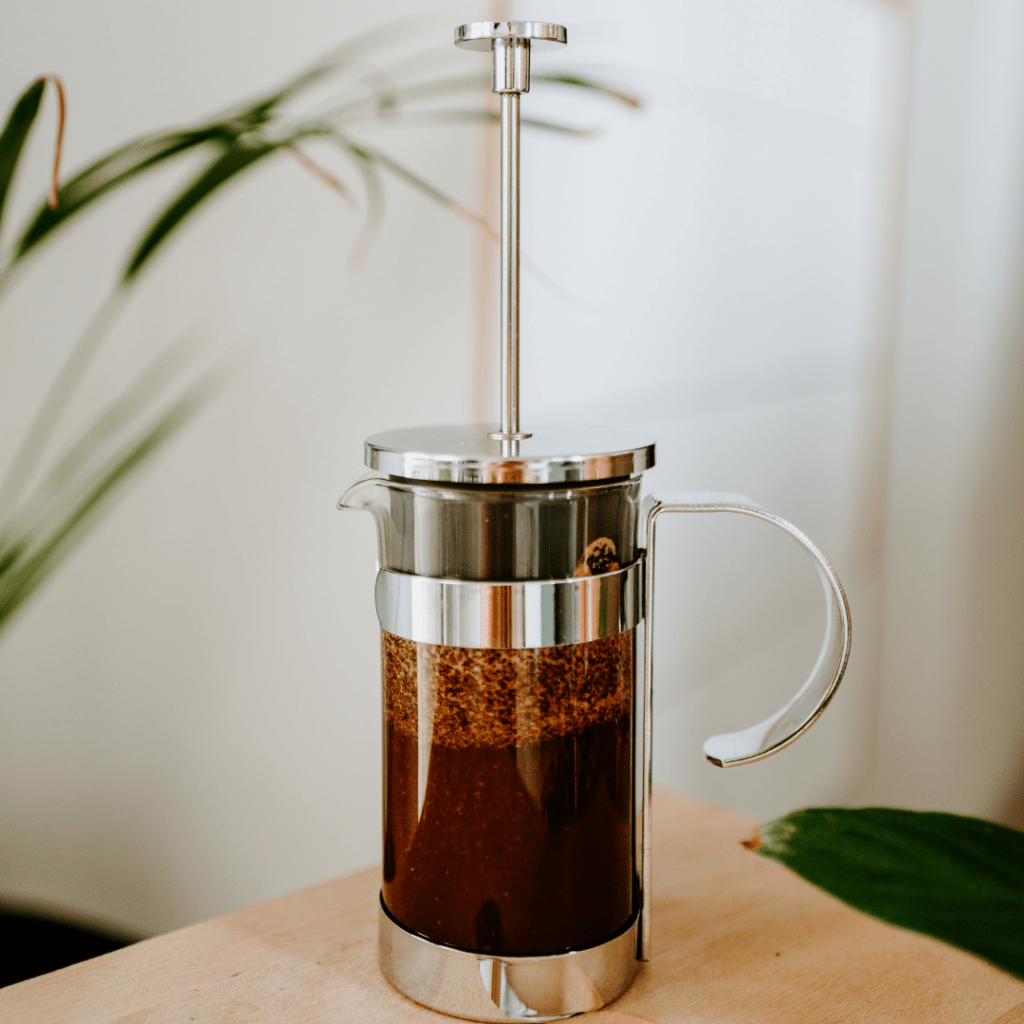
Equipment List For French Press Coffee
When you unpack a French press coffee maker, chances are, you’ll find the owner’s manual that gives a compressed version of brewing instructions:
· Add coffee to the carafe
· Pour in hot water
· Hold on for about 4 minutes
· Plunge
· Enjoy your coffee
Well, this procedure could work, but if you want to enjoy a tasty cup of java, you need to do a little bit more than that.
Here are the exact things you need to make the best coffee with French press.
Filtered Water
Water matters. Filtered water really is best.
The reason?
It doesn’t contain any odor or impurities that would deprive your coffee of its natural aroma and flavor.
Coffee Beans
Some coffee enthusiasts go for ground coffee because it saves them time and cuts the prep time by half.
The only problem?
Ground coffee can go stale, especially if not well packaged and that can hugely tamper with the overall taste of your coffee.
Pre-ground beans often undergo oxidation, thus losing their taste over time.
On top of that, if not stored well, pre-ground coffee may pick up other smells from the kitchen and pass them to your cup.
No judgement here, if you’re short on time pre-ground coffee can be a lifesaver.
If you’ve got the time though …
Whole Beans
The secret to brewing a mouth-watering cup of Joe using French press is to grind your own coffee beans.
Generally, freshly ground beans will produce a mighty cup.
And not just any beans. French press experts often prefer medium to dark roast beans mainly because of the slower extraction of flavor, oils and brewing character.
So, how do you select the best coffee beans for French press brewing?
Look for the following keywords:
· French roast
· Smoky
· Smooth
· Cocoa
· Chocolate
· Full-bodied
· Nutty
· Woody
· Nutty
· Spicy
· Caramel
· Earthy
And when we talk about coffee beans, the next item on the list must be:
Burr Grinder
As already mentioned, nothing delivers the flavor that freshly ground coffee beans do.
Burr grinders allow you to achieve a uniform grind. One that lets you set your own grind size is even better because it will produce a more balanced and fuller drink.
Why do we recommend a burr grinder? For its performance and consistency.
Review: Baratza Encore Conical Burr Grinder
Coffee Scale
You might be wondering why you need a coffee scale when you can just use a scoop?
Well, measuring the right amount of coffee gives you a consistently tasty cup of coffee.
You no longer need to guess about how much coffee you should use every time.
Kettle
As we mentioned earlier, hot water is part of the requirement. A convenient, easy and safe way to boil and pour the water into the French press is to use a kettle or stove-top.
Good electric kettles will give you a temperature reading of the boiling water.
But if you don’t use a kettle with a reading, you can opt for an instant-read thermometer to know the hot water’s temperature before you pour it into the ground coffee.
You also need a mug and timer.
How to Use a French Press to Brew Tasty Coffee
So, you’ve got all the above requirements on your kitchen countertop.
Now, let’s move to the interesting part: brewing.
When brewing coffee with French press, we recommend using 1.6g to 2g of coffee for every 29.57 ml of water (one fluid ounce of water).
When you grind your beans use a coarse setting for optimal extraction.
If you use finely ground coffee, you’ll most likely end up with over-extraction, which often means, an unpleasant, bitter drink along with a clogged filter.
To make a pleasant and delicious cup of coffee using French press, follow these steps:
1. Boil filtered water
Once the water comes to a full boil, remove it from heat, and let it cool to approximately 200℉. This should be about 30 seconds after the water boils. When boiling the water, add a little extra time for preheating the French press.
2. Preheat the French press
Pour some hot water into the carafe. Push the plunger through hot water to the bottom. Pour out the hot water.
3. Grind the beans
For optimal freshness you should grind the whole beans immediately before brewing.
4. Put ground coffee into the carafe and then add hot water
A minute later, you’ll see the coffee grounds floating to the surface as they form a crust. Stir it with a wooden spoon and the grounds will move to the carafe’s bottom.
5. Wait for 3 minutes
Cover the carafe with a lid and pull the plunger to a surface above the water. Wait for 3 minutes.
6. Plunge
Slowly, push the plunger to the bottom.
7. Pour
Next, serve your coffee immediately. If you let it stay in the carafe, it will keep brewing and develop a bitter taste.
8. Enjoy
No details needed!
9. Clean the French press after use
You want your next brew to taste great, right? Oil remnants and coffee grounds on the filter and carafe will ruin your coffee’s taste.
That’s why you should check the manufacturer’s instructions for cleaning the machine. While at it, be sure to disassemble the filter to remove any residual oils and deposits.
For the most part, you’ll need to clean it using a mild detergent and then dry it afterwards.
Tips for French Press Brewing Perfection
By following the steps above, you’ll enjoy a delicious cup of Joe. But, it’s possible to experience a bitter taste in the mouth if you don’t brew correctly.
Follow these tips to ensure your coffee is tasty rather than bitter:
Start by buying quality coffee beans
Do your due diligence to purchase only the best whole bean coffee. Grind the beans immediately before brewing.
Pour Immediately
Bitterness often results from over-extraction. Letting the grounds be in contact with the coffee after brewing is complete will cause over-extraction. That’s why we recommend that you pour the coffee without delay.
Use a burr grinder
The other cause of bitterness is uneven grinding. Typically, finely ground coffee tends to extract faster than larger, coarsely ground coffee. Thus, use a burr grinder or change the grinder’s burrs if they are too old.
Use water at the right temperature
Piping hot water may scorch your coffee and make it bitter. The best temperature is approximately 200℉. You can attain this temperature by letting water boil and allowing it to sit for a minute.
Advantages of the French Press
Now that we know what it takes to make a mighty cup of coffee with French press, let’s look at its upsides.
User-friendly
You don’t need former brewing skills to use this method. Just follow the steps above and you’ll be a pro in record time!
Affordable
There’s a cost variation for French presses, but you can find budget machines for effective brewing.
It doesn’t require a lot of gear
Once you have the French press, you only need a burr grinder, coffee beans, a coffee scale, kettle, and a timer (an iPhone can still do!).
Super customizable
The brewing process is dead simple, which gives room for customization or experimenting to see what works for you.
If you discover the coffee is very strong, you may reduce the coffee amount to the same water volume, increase the steeping time, or increase the coarseness of the grinds.
But if the coffee is weak, you may do the opposite: increase the coffee-to-water ratio or lengthen steeping time.
Full bodied taste
The resulting coffee from French press is usually bold, rich, and full-bodied – an endearment for coffee aficionados.
These attributes originate from the quantity of coffee oils that get into the beverage and the contact duration between the water and grounds.
Decent brew capacity
Want to brew enough coffee to enjoy with friends during a party or share with colleagues at the office? The French press will serve you well.
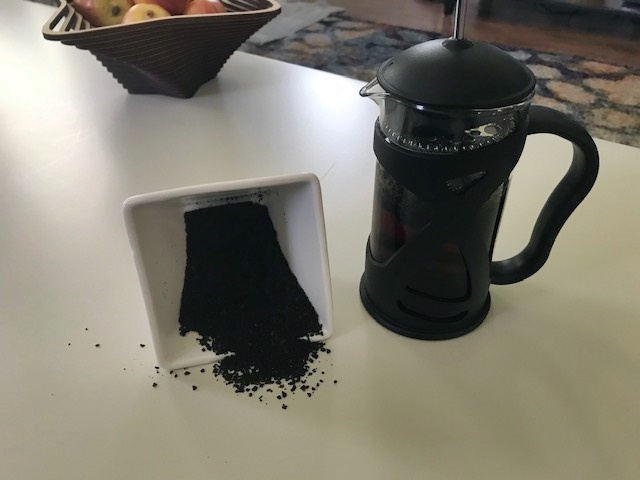
Disadvantages of French press
Here are a few downsides of using French press to brew coffee:
Slow
Compared to other methods of brewing coffee, French press can take quite a while. This can be inconveniencing, especially if you’re in a hurry or simply wouldn’t want to spend a lot of time making coffee.
Gritty drink
A common issue with French press is the presence of silt or grit in the cup. This can be avoided by using a quality French press though.
Flavor
French press gives you rich and full-bodied coffee, but it may mask the tones found in most single-origin beans, particularly the light roasts. Use the best coffee for French press for optimal results.
Finicky to clean
The brewer’s metal filters can be taxing to clean, as old ground deposits easily get trapped in the mesh.
Pour Over Overview
Like French press, pour over involves pouring boiled water over ground coffee.
The only difference is that the pour over method involves placing the grounds in a cone-shaped container.
You place the grounds on the cone’s top, wet them and allow them to rest for a while before adding more water.
The filter allows the added water to penetrate the coffee grounds in a circular or side-by-side movement, thus preventing them from being in contact with water for a long time.
The resulting brew is smoother and lighter without any grit whatsoever.
Pour over has been around since the 1900s where it was widely used in Europe. But, just like the French press, its popularity is on the rise these days.
It’s also termed as the infusion method, meaning coffee extraction occurs by steadily pouring or infusing fresh water through the coffee grounds.
Pour over is the manual version of how drip coffee makers work.
Do you like it when your coffee has a texture similar to that of tea?
If you’re nodding, then pour over should be your favorite brewing method.
Why so?
The short contact duration between coffee grinds and water results in a much lighter and brighter drink whose texture is close to that of tea.
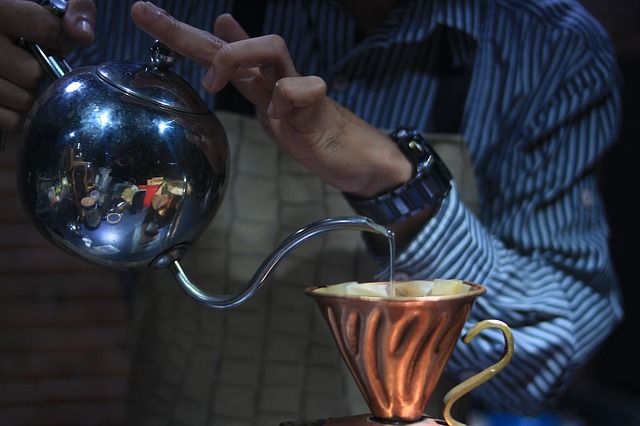
Who uses pour over the most?
Both home brewers and third wave coffee shops have fallen head over heels with this method.
And the reason is simple: Pour over brings out the intricate flavors in different coffee beans.
Unlike French press, coffee from pour over is typically drunk black because adding milk or other ingredients might end up diluting the nuanced flavors – the thing that makes this method special.
How It Works
Before we look at how to make coffee with this method, let’s first look at what you need.
Equipment List For Pour Over Coffee
There’s no cutting corners if you’re looking to brew the tastiest coffee of the century.
Other than the obvious – a pour over coffee machine, you’ll need the following tools:
· A quality burr grinder
· A coffee filter
· A coffee scale – to measure coffee in grams
· A gooseneck kettle – to pour hot water at an optimal rate and flow
· Fresh water
· A thermometer to help check the water temperature
· A serving vessel (this is optional)
How to Brew Coffee Using Pour Over
Grind the beans, pour water, and enjoy tasty coffee, right?
Well, the truth is, this brewing technique requires some practice and ounces of patience.
But that doesn’t mean you can’t use this brew style to make delicious coffee the very first time.
Follow our step by step guide to brew smooth, aromatic, and rich coffee.
1. Heat Fresh Water to 195 to 205 Degrees Fahrenheit
It’s important that you get your water to that temperature range.
You can use a thermometer, but if there isn’t one, get the water to a boil, remove it from the heat, and let it sit for half a minute before you start brewing.
2. Weigh the Coffee
The coffee-to-water ratio affects flavor in a massive way. So, you should be keen on the amount of coffee.
Most people use 1 gram of coffee for every 18 grams of water. This translates to 9 – 11g of coffee for a 6oz (171g) cup you brew.
Here’s what the best baristas agree on to be the correct coffee-to-water ratio for pour over: 1:19 or 1:16.
As a rule of thumb, more coffee equals more flavor.
You may need to experiment with different ratios to find out what works for you.
3. Wet the Filter
Would you sip coffee that tastes like paper twice? Most people won’t.
And the easiest way to get rid of that paper taste is to wet or rinse the filter.
For effective rinsing, unfold the filter and place it into the cone. Now, place the cone on top of your mug or carafe and pour hot water in a circle for approximately 5 seconds to pre-wet the filter.
Lastly, discard the used water in the carafe or cup that rinsed the filter.
4. Grind Your Beans
Be sure to grind the coffee beans immediately before brewing so you don’t lose flavor. While a fine grind creates more flavor, it might lead to bitterness.
What about a coarser grind?
It brews a sweeter cup, but the outcome can be weak, acidic, and under-extracted coffee.
Your homework: find the ideal particle size. Most experts agree that a medium-fine grind works well, like sand or sea salt.
Want to experiment further?
Choose the middle of the grinder’s settings and note down how the brew tastes.
For a milder flavor, use a coarser grind.
For a richer flavor, try a finer grind.
5. Add the Ground Coffee to the Wet Filter
6. Pour Water
This step has two phases: bloom and brew time.
Bloom: Start by pouring a small volume of water over the ground coffee and watch it be soaked up.
The grounds will start to swell, bubble, and rise.
This is the blooming process. Give it about 30 secs.
Brew time: Next, pour the remaining water over the grounds in spiral motion.
Start in the middle and move to the sides.
Tips for a Perfect Pour Over Brew
To learn how to make the best pour over coffee, keep the following points in mind:
Pour at a consistent rate
The way you pour hot water over the grounds determines the degree of extraction. That’s why we recommend using a gooseneck kettle. Keep this kettle at the same height and let water flow out at the same rate when pouring.
Ensure water is at the right temperature
Aim for 195 – 206o F or 90 – 96o C.
Use hot water to wet the filter for about 5 seconds to help remove any odor in it.
Bloom the coffee
After pouring a little water, wait for 30 seconds for the coffee to bloom. This removes carbon dioxide from your coffee, making it less bitter.
Ensure all the grounds are immersed in water during extraction
It’s crucial for grinds to be immersed in water during the entire brewing process. After pouring all the water, the grounds should not start drying.
Simply put, they should stay immersed and soaked when pouring water.
Also, when blooming, all grinds should be evenly soaked without any dry patches. The reason is dry patches cause uneven extraction, which creates poor flavor.
Achieve a flat grind bed after pouring the water
After all water is drained from the cone, the resulting grind bed should be flat, or a little domed.
A concave shaped grind bed means that some grinds are stuck on the walls and thus less extracted than those at the center of the filter.
Here’s a quick solution for that:
Gently stir the slurry after pouring all the water.
Not only will this action remove grinds from the walls, but it will also enhance even extraction.
Be Consistent
An essential part of this process is consistency. It’ll go a long way to help you rectify any errors and allow you to experiment once you master the basics.
That’s why we recommend that you exercise consistency in the following areas:
· Use a top-notch burr grinder (to get the correct grind size)
· Measure your coffee and water on a good quality and accurate scale
· Use a gooseneck kettle for even pouring of water on the grounds
· Always use clean, fresh, and good quality water
· Consider recording everything right off the bat so you can refer to it next time
Advantages of Pour Over
So here are a few reasons behind the popularity of this brew style:
It creates a nuanced and light coffee that most people love
This method can make both bright and light coffee. It also highlights the flavors and tones of various single origin coffees.
But that’s not all.
Specialty coffee fans praise pour over coffee because of its delicious taste.
Overall, pour over coffee feels smooth on your palate and the flavor is less intense than that of coffee made with a French press. Lack of immersion for pour over makes this possible.
Clean up is a piece of cake
Cleaning pour over coffee makers is easier than cleaning a French press (which requires dismantling). Just lift up the filter together with the grinds and dispose of it.
After that, simply rinse the cone using hot soapy water.
We understand that cleaning is the least sexy part of brewing coffee, but it impacts the flavor as well. So, don’t neglect it.
You get a clean cup
A clean cup in this case simply means coffee without any grit and the texture resembles that of tea.
This is unlike French press coffee that can get gritty if you use a very fine grind size or an ineffective screen filter.
The process is exciting
The truth is once you start using pour over to make your coffee, you won’t just enjoy the taste of the drink, but you’ll find the process entertaining as well.
From gently pouring hot water over the grinds to watching the gases escape in the bloom, the pour over process has a way of becoming an entertaining part of a coffee enthusiast’s morning routine.
Affordable
Generally, you can find paper filters and pour over cones at a bargain.
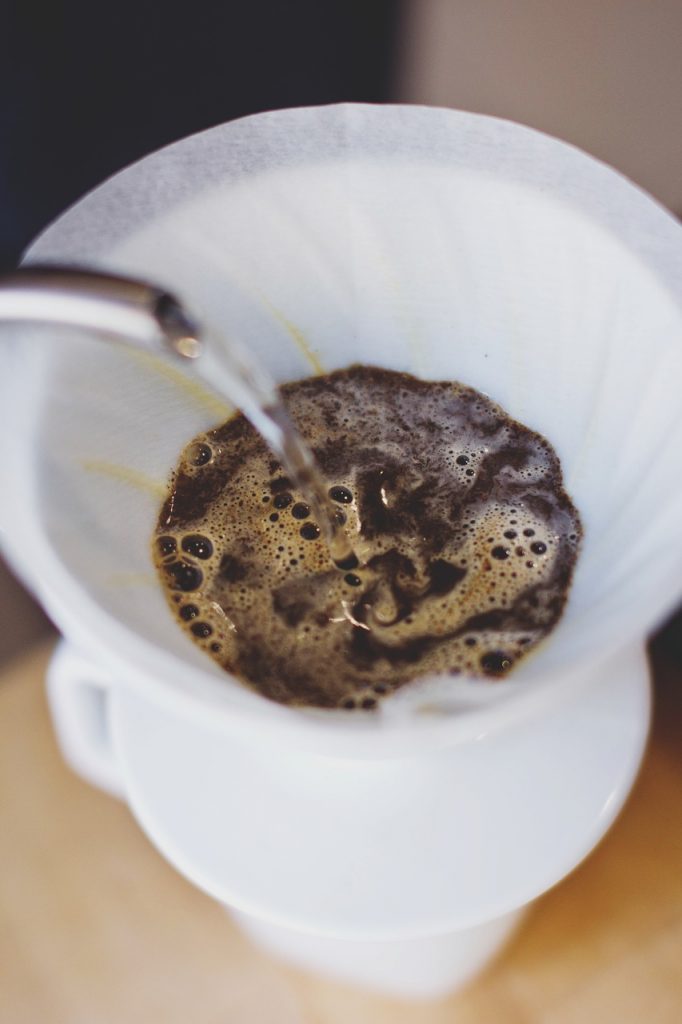
Disadvantages of Pour Over
You need essential gear to make a decent cup
Unlike French press, brewing coffee with pour over requires additional equipment like the coffee scale, a gooseneck kettle, and a paper filter.
Purchasing this set of equipment can easily add up the total price. But hey, the ultimate taste of coffee you get from using this method is worth the investment.
Requires patience and practice to get it right
With a pour over, it might take time and effort to finally master the art of brewing a cup you can be proud of. French press is a more forgiving coffee maker than pour overs.
Low brew capacity
A pour over is perfect for making 1 to 2 cups at a time. So, unlike a French press, it’s not ideal for large groups.
But it’s important to note that there are pour overs that can brew in large batches. Examples include Bodum and Chemex.
Pour over coffee may not appeal to everyone.
Sure, most people enjoy the bright and light body of pour over coffee. But coffee lovers who prefer coffee with a rich and fuller body may find this coffee disappointing.
Our Top Pick for French Press: Kona French Press
The Kona French press is among the few French press machines with a protective design. The exterior shell is not only eye-catching but also insulated.
It protects the extra thick glass carafe from possible chips and cracks. Compared to other thin metallic French press frames that corrode and can’t protect the carafe, this one is sturdy, stylish, and super durable.
Featuring a comfortable handle, you can easily pour coffee to several mugs without strain. The handle extends to a BPA and BPS free lid and plastic touches your cold or hot brewed coffee while steeping.
You can use this coffee maker at the office because it’s quiet and non-electric.
Want to brew great coffee while RVing, hiking, or going for road trips? No worries, as this machine is compact and portable.
The top-grade, big, 8 cup-size coffee pot is designed from borosilicate glass, which makes it thermal shock-resistant, ideal for RV campers.
And we saved the best for last: the filtration system is superior.
It consists of a three-piece stainless steel filter system to guarantee taste-free parts that won’t alter the natural taste of your fresh beans.
Reviewers tend to complain about two things:
- The coffee maker lacks insulation, which is why coffee may cool after 20 to 30 minutes. But, as we mentioned earlier, you should serve the coffee immediately to prevent it losing heat and over-extracting.
- The carafe’s lid loosely fits and may require you to hold it during pouring.
Our Top Pick for Pour Over: Hario V60 Ceramic Pour Over
Made in Japan, the V60 is known to coffee lovers all over the world.
And its popularity starts right from the design material: ceramic.
Ceramic retains heat, ensuring the brewing cycle proceeds at a constant temperature.
And the cone shape is not just admirable on the countertop; it also helps to accentuate those coffees with fruit or floral notes.
V60 features spiral ribs, which allow coffee to expand, releasing its best flavors during extraction.
Having said that, this unit takes some time to get used to, which is why beginners may take a while to master it.
Final Word
This guide on French press vs. pour over helps us to see the pros and cons of each brewing method.
If you’re still torn between French press vs. pour over, don’t stress it. It all boils down to this: your taste preferences and lifestyle.
If you prefer coffee that’s bold, rich, and strong; enjoy thick-textured coffee; and want a little flexibility with the ground types you can use, then French press will work for you.
But if you enjoy java with a brighter and lighter body and more subtle flavor, want to brew a cup or two at a time, dislike gritty coffee, or prefer a coffee maker that’s easy to clean, you should opt for the pour over.
Since you can find both pour over and French press coffee makers on the cheap, you can try each of them and see what works for you. Or better, keep alternating them.
Happy Brewing!
